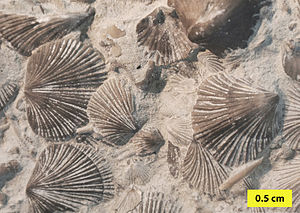Articulata (arm pods)
| Articulata | ||||||||||||
|---|---|---|---|---|---|---|---|---|---|---|---|---|

Cincinnetina meeki |
||||||||||||
| Systematics | ||||||||||||
|
||||||||||||
| Scientific name | ||||||||||||
| Articulata | ||||||||||||
| Williams et al. 1996 |
The Articulata are closed bearing (articulate) brachiopods (Brachiopods) with kalzitischer shell. The lock edge is formed by the edges of the rear interarea (the shell area between the vertebra and the lock edge). The lock usually consists of a pair of ventral teeth (sitting on the lock flap) and a pair of dorsal (sitting on the arm flap) tooth pits. The shells are moved by an apparatus that works against each other by opening muscles (diductores) and sphincter muscles (adductores). Stalk muscles (adjustores) control the stem.
The Articulata are by far the largest group of brachiopods and contain around 90% of the 4,500 genera, of which only a few occur recently . Due to their calcareous shells, however, they are well preserved as fossils ; the taxonomic subdivision is based on the shape of the shells and lock formations. For the delimitation of the geological ages within the geological time scale , the articulata have been of great stratigraphic importance since the Lower Cambrian .
Systematics
In order to be able to better group the brachiopods combined in the Articulata together with newly discovered fossil species of the classes Chileata , Obolellata , Kutorginata and Strophomenata , the sub-strain Rhynchonelliformea was recently introduced in paleontology . As recent, so still existing species of the Articulata are the orders

